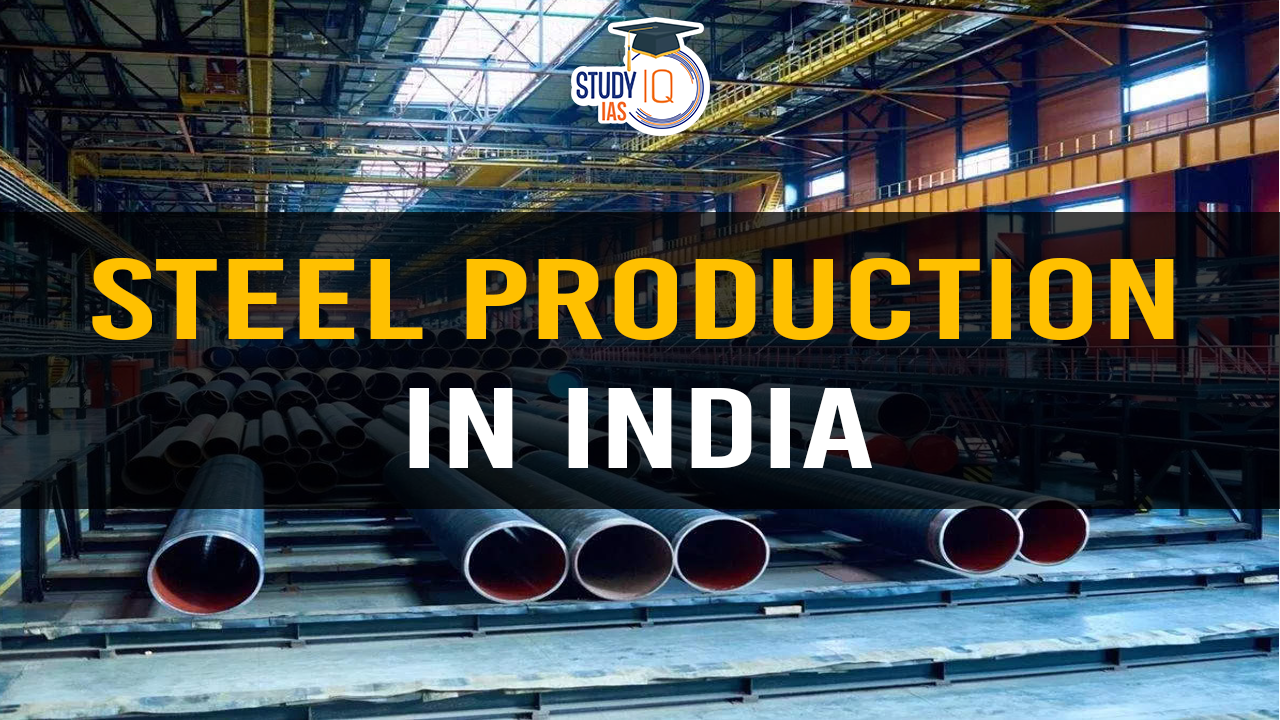Table of Contents
Context: To protect the domestic steel industry from a surge in low-cost imports, the Indian government has imposed a 12 percent provisional safeguard duty on certain non-alloy and alloy steel flat products.
Amidst a backdrop of global economic slowdown, India stands out as a beacon of growth in the steel industry, recording positive growth among the world’s top five crude steel producers in April 2024. According to the latest data from the World Steel Association, India, the second-largest producer of crude steel globally, achieved a commendable growth rate of 3.9% compared to April 2023.
Steel Production in India
Steel production in India has emerged as a vital pillar of the nation’s industrial growth and infrastructure development. India’s steel industry has experienced significant growth, with crude steel production reaching 144.3 million tonnes in the fiscal year 2023–24, up from 109.1 million tonnes in 2019–20. India is the 2nd largest steel producer in the world (after China).
- Crude steel production (2023): ~125 million tonnes (MT)
- Major players: SAIL, Tata Steel, JSW Steel, JSPL, etc.
- Employment: Directly and indirectly employs over 2 million people.
Challenges Faced by the Indian Steel Industry
- Surge in cheap imports, especially from China, South Korea, Vietnam, etc.
- Price volatility in global markets
- High input costs: Coking coal, logistics.
Key Findings of the Latest Data
- India is the only country among the top five crude steel producers to achieve positive growth, marking a 3.9% increase in April 2024 compared to April 2023.
- Global crude steel production witnessed a decline of 5.0% in April 2024 compared to the previous year.
- China, the largest steel producer, recorded a 7.2% decline, while other major producers like Japan, the United States, and Russia also experienced decreases in production.
- Top steel producing countries: (1) China (2) India (3) Japan (4) USA (5) Russia
| What is Green Steel? |
|
Reasons for India’s Positive Growth
Infrastructure Projects
- The Indian government’s focus on large-scale infrastructure projects in railways, roads, and ports has significantly boosted steel demand.
- These initiatives aim to enhance connectivity, stimulate economic growth, and create employment opportunities.
Automotive Sector
- Rising demand for vehicles, including cars, two-wheelers, and commercial vehicles, has contributed to increased steel consumption.
- Improved road infrastructure and economic growth have fueled this demand.
Government Policies
- Supportive policies such as the “Make in India” campaign and favourable foreign investment policies have created an enabling environment for industrial growth, including the steel sector.
- These policies have attracted investments and facilitated the expansion of steel production capacities.
Steel Sector in India
The foundation of India’s modern iron and steel industry dates back to 1875 with the establishment of a blast furnace plant at Kulti near Calcutta (now Kolkata). Notably, Jamsetji Nusserwanji Tata played a pivotal role in shaping India’s steel industry by setting up the Tata Iron and Steel Company (now Tata Steel) in 1907 at Jamshedpur, Jharkhand.
Today, India holds the distinction of being the world’s second-largest producer of crude steel after China. Furthermore, it is the largest producer of sponge iron globally and ranks as the third-largest user of finished steel, following China and the United States.
Implications and Future Outlook
- India’s positive growth in steel production amidst a global downturn highlights its resilience and potential as a major player in the global steel market.
- Continued prioritisation of infrastructure development, industrial growth, and supportive policies will further enhance India’s position in the steel sector.
- With its rich history, robust capabilities, and strategic initiatives, India is well-positioned to maintain its upward trajectory in steel production, contributing to both domestic prosperity and global competitiveness.


 RBI issued New Guidelines regarding Liqu...
RBI issued New Guidelines regarding Liqu...
 Donald Trump’s Reciprocal Tariffs: Imp...
Donald Trump’s Reciprocal Tariffs: Imp...
 Growth in Gold Loans and NPAs, Reasons a...
Growth in Gold Loans and NPAs, Reasons a...






















